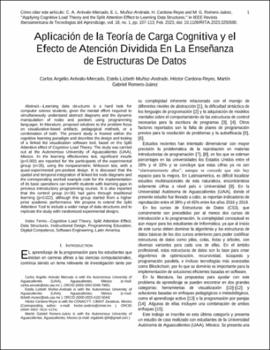Aplicación de la Teoría de Carga Cognitiva y el Efecto de Atención Dividida En La Enseñanza de Estructuras De Datos
Date
2023Abstract
Learning data structures is a hard task for
computer science students, given the mental effort required to
simultaneously understand abstract diagrams and the dynamic
manipulation of nodes and pointers using programming
languages. In literature, proposed solutions to the problem focus
on visualization-based artifacts, pedagogical methods, or a
combination of both. The present study is framed within the
cognitive learning paradigm and describes the design and testing
of a linked list visualization software tool, based on the Split
Attention effect of Cognitive Load Theory. The study was carried
out at the Autonomous University of Aguascalientes (UAA),
Mexico. In the learning effectiveness test, significant results
(p=0.000) are reported for the participants of the experimental
group (n=35), using the nonparametric Wilcoxon test, with a
quasi-experimental pre-posttest design. It is discussed that the
spatial and temporal integration of linked list node diagrams and
the corresponding worked example code for the implementation
of its basic operations can benefit students with learning gaps in
previous introductory programming courses. It is also reported
that the control group (n=36) had gains through traditional
learning (p=0.022), although this group started from a higher
prior academic performance. We propose to extend the Split
Attention Tool to include a wider range of data structures and to
replicate the study with randomized experimental designs.





